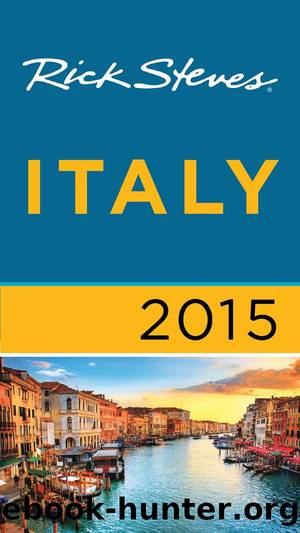Rick Steves Italy 2015 by Rick Steves

Author:Rick Steves [Steves, Rick]
Language: eng
Format: azw3, epub
Publisher: Avalon Travel
Published: 2014-10-14T00:00:00+00:00
⢠Look for the marble altarpiece decorated with statues.
Piccolomini Altar: This was designed for the tomb of the Sienese-born Pope Pius III (born Francesco Todeschini Piccolomini). It was commissioned when he was the cardinal of Siena, but because he later became a pope (see the fresco of his coronation with Pius wearing the golden robeâabove and to the right of the Michelangelo statue), he was buried in the Vatican, and this fancy tomb was never used. Itâs most interesting for its statues: one by Michelangelo, and three by his students. Michelangelo was originally contracted to do 15 statues, but another sculptor had started the marble blocks, and Michelangeloâs heart was never in the project. He personally finished only oneâthe figure of St. Paul (lower right, clearly more interesting than the bland, bored popes above him).
⢠Now grab a seat under the...
Dome: The dome sits on a 12-sided base, but its âcofferedâ ceiling is actually a painted illusion. Get oriented to the array of sights by thinking of the church floor as a big 12-hour clock. Youâre the middle, and the altar is high noon: Youâll find the Slaughter of the Innocents roped off on the floor at 10 oâclock, Pisanoâs pulpit between two pillars at 11 oâclock, a copy of Duccioâs round stained-glass window at 12 oâclock, Berniniâs chapel at 3 oâclock, the Piccolomini Altar at 7 oâclock, the Piccolomini Library at 8 oâclock, and a Donatello statue at 9 oâclock.
Pisanoâs Pulpit: The octagonal Carrara marble pulpit (1268) rests on the backs of lions, symbols of Christianity triumphant. Like the lions, the Church eats its catch (devouring paganism) and nurses its cubs. The seven relief panels tell the life of Christ in rich detail. The pulpit is the work of Nicola Pisano (c. 1220-1278), the âGiotto of sculpture,â whose revival of classical forms (columns, sarcophagus-like relief panels) signaled the coming Renaissance. His son Giovanni (c. 1240-1319) carved many of the panels, mixing his dadâs classicism and realism with the decorative detail and curvy lines of French Gothicâa style that would influence Donatello and the other Florentines.
Download
This site does not store any files on its server. We only index and link to content provided by other sites. Please contact the content providers to delete copyright contents if any and email us, we'll remove relevant links or contents immediately.
Annapurna by Maurice Herzog(3301)
Liar's Poker by Michael Lewis(3228)
A Forest Journey by John Perlin(2918)
Atlas Obscura by Joshua Foer(2706)
The Ogre by Doug Scott(2506)
Cuba by Lonely Planet(2490)
Photographic Guide to the Birds of Indonesia by Strange Morten;(2408)
Tokyo by Rob Goss(2293)
All Things Reconsidered by Bill Thompson III(2263)
The Splendid and the Vile by Erik Larson(2231)
A TIME OF GIFTS by Patrick Leigh Fermor(2103)
INTO THE WILD by Jon Krakauer(2086)
Fatal Storm by Rob Mundle(2083)
Trail Magic by Trevelyan Quest Edwards & Hazel Edwards(2063)
DK Eyewitness Top 10 Travel Guides Orlando by DK(2058)
Abbey in America by Murray John A(2018)
Top 10 Dubai and Abu Dhabi by DK Travel(1991)
Touching the Void by Joe Simpson(1975)
Lonely Planet Australia by Lonely Planet(1974)
